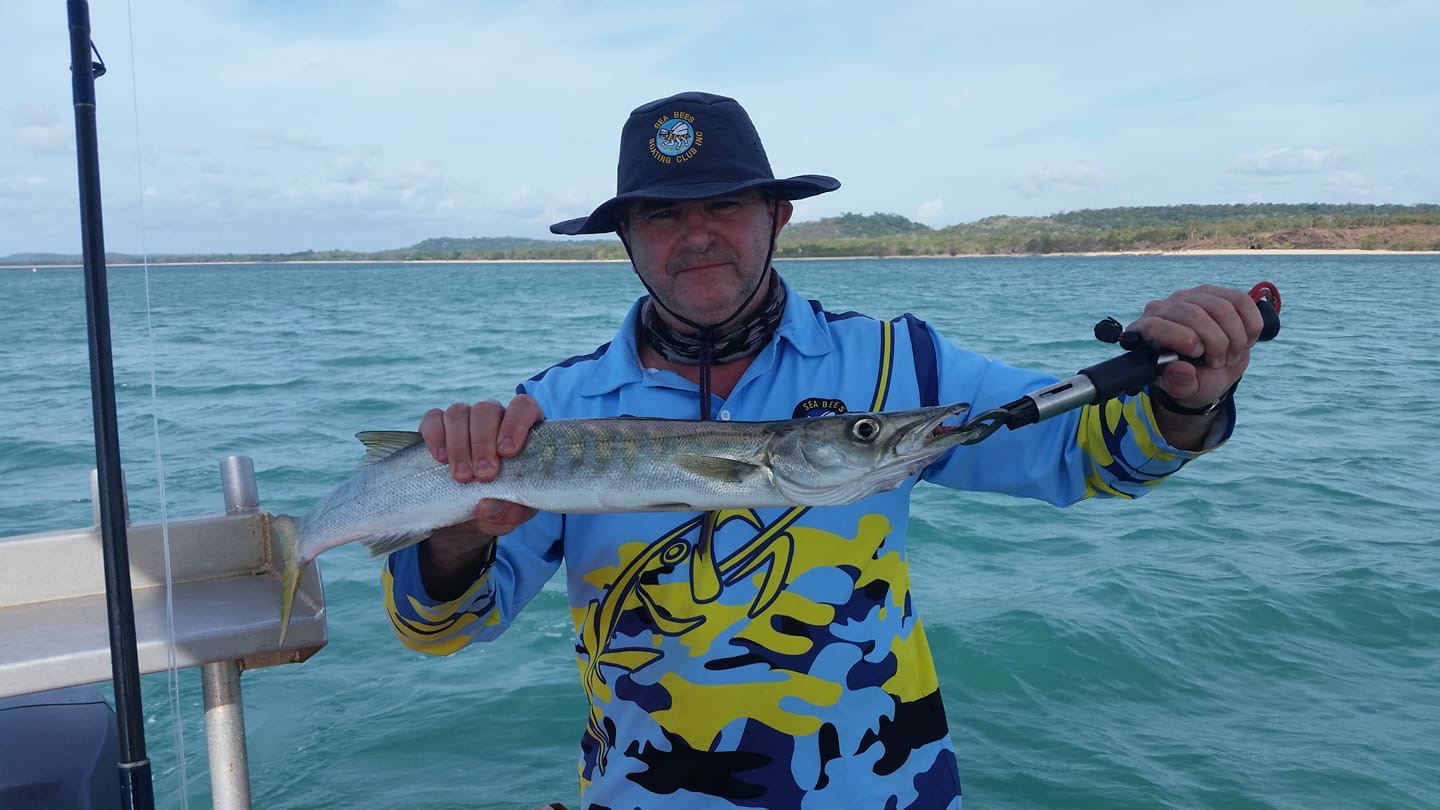It's an honour and privilege to be elected as President of the Sea Bees this year.
November Meeting
Awesome Inspection Day!
Jason and his Haines Hunter
Our annual Inspection Day was held Sunday 28th October 2018 and it is much gratitude that we thank David Little, Boating Education Officer from NSW Maritime for his time, good humour and professionalism.
Nine boats and about 15 members were on hand to have David educate us about current legal boating requirements and check our boats for all safety equipment. Before he could get started however, there were a fair few excitable members with ‘their toys’ crawling over each others rigs, checking out different set ups, swapping tips and ideas and wisdom learned from experience.
Barry’s new Anglapro
New boats were seen for the first time; new member Jason was, I believe, glad to gain updated information
Barry was able to show off the new Anglapro, as was Mark with his new Quinnie.
Thanks to Mark and Paul for their tireless provision of sausage sandwiches.
A great day overall. Thanks to all for attending and making it a success. A gallery pf pictures for the day is available here; www.seabeesfishingclub.com/boat-inspection-2019/
Pearcey in Senesia!
First day fishing at Siesia was very windy and the fishing was slow. Only a couple of smelly barracuda for me. Nephew got a nice spaniard.
Barracuda!
Latest from Alex Bellisimo
OPINION: Redfin on the rise
YOU may know these fish as European perch, English perch or just plain redfin. The fact is the highly invasive class one noxious species (in NSW) is fast spreading throughout previously redfin-free waters.
My first introduction to redfin came after the completion of two dams in the Central West of NSW: Burrendong in 1967 and Carcoar Dam in 1970 The colonisation of these two dams was rapid and boat loads of redfin could easily be caught soon after these dams were open to the public. Bobbing was the most popular method of catching redfin as hundreds could be caught in a session.
Balitic Bobbers adorned the wall of many a local garage and barbers shop. Local angler Bill Ryan had a weekly fishing report on Prime TV that consisted mostly of catching redfin in Burrendong Dam.
Of course, worms could always take their fair share of redfin but the bite was so voracious that constantly baiting of the hook was foregone for the ease of a bobber. These were pimped up by some by adding red wool to the hooks.
The ease with which redfin could be caught was a hit with adults and kids alike and it was this willingness to bite that saw unthinking anglers translocate redfin to waters previously free of redfin.
Chifley and Oberon Dams were to many "blue ribbon trout fisheries" and the visiting anglers were numerous. The fishing mags wrote of these two dams with glowing praise.
Oberon was probably better known for its fly fishing, as it was then only bank fishing, whereas Ben Chifley was open to boats and was excellent for trolling and casting.
Redfin were translocated to a farm dam in the catchment above Ben Chifley Dam. A big rain event caused the dam to overflow and the water along with redfin made its way down into the creek that eventually joins the Campbells River and then is captured by the dam itself.
Oberon locals are adamant in their claims that a couple of their own brought a bucket of redfin back from Ben Chifley Dam to put into Oberon Dam so the kids would have something to catch. There are also reports that the dam below the visitors center at Oberon was also stocked by the same anglers.
The effect on trout stocks was a virtual decimation of every trout in the two dams in a very short time. Stocking of trout fry continued with little effect going on catch rates of trout.
While all this was happening in western flowing waters (some water from Oberon Dam is diverted to the east via the Fish River Water Supply) the eastern catchment was still free of redfin.
In 2010 the local newspaper ran a report of another farm dam stocked with redfin, this one in the eastern catchment. NSW Fisheries were quick to act and the redfin were removed, but it would seem the damage had already been done.
This small dam had already spilled over into Coxs River during previous rain events and redfin soon found their way down into Lake Wallace where their numbers exploded. Then Lake Wallace spilled, allowing redfin to move down into Lake Lyell where the numbers have continued to grow rapidly.
It will be of great interest to see how the trout and bass numbers in Lake Lyell stand up to the onslaught of the redfin.
Lake Lyell has also spilled over since the redfin have become established there, so the threat of infestation of Warragamba Dam with redfin is very real and nearly assured.
Wentworth Falls Lake in the Blue Mountains in recent years was also found to have redfin introduced. This lake spills into the Jamison Creek, which joins the Kedumba River and then onto Coxs River.
Many anglers love to target redfin for their fighting abilities, their superb eating qualities and their eager response to lure, fly or bait BUT the act of purposely translocating these fish has caused immense damage. Redfin can carry a virus which has the potential to wipe out our native fish along with our desirable introduced species. Redfin can also rapidly populate a waterway predating on fry and eggs of other species, thus making it redfin only water.
Redfin were recorded as eliminating 20,000 newly released rainbow trout fry from a reservoir in south-western Australia in less than 72 hours. These rapidly breeding fish soon become so numerous that the limited feed and over-crowding often sees the fish succumbing to stunting.
One thousand redfin taken during a recent competition at Lake Lyell.
“Redfin Round Ups” and fishing competitions are focusing more and more on these voracious predators. A recent comp run at Lake Lyell by The Fishing Factory from Orange saw in excess of 1000 redfin caught. While this is a very impressive number it is worth noting that if a thousand redfin were removed every day of the year (365,000 redfin) that equates to less than the number of eggs that two breeding pairs of redfin can spawn in year themselves.
NSW DPI Fisheries are changing the way they are combatting the spread of these voracious predators by stocking larger trout along with ex brood trout instead of fry. This is proving very successful with quite a few trout caught at the recent Recent Redfin Roundup at Oberon Dam, along with a lot of trout again being caught in Carcoar Dam.
Targeting redfin is quite easy. As the weather warms redfin can be easily caught from the bank using bait, lure or fly. During the colder weather the redfin hold deep in the old flooded river beds and deep jigging is the most successful method of getting a feed.
One of the best eating fish going, many out this way refer to the delectable fillets as "bush whiting". Don't get caught with live redfin in your bucket or Esky in your boat as that is risking a fine in NSW.
Read more at http://www.fishingworld.com.au/news/opinion-redfin-on-the-rise#lkbDDWC01U08xKdM.99






